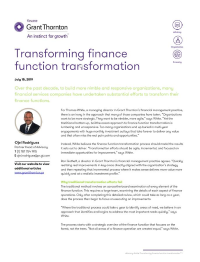-
Financial statements audits
Financial statement audits
-
Compliance audits
Compliance audits
-
Compilations and reviews
Compilations and audit
-
Agreed-upon procedures
Agreed-upon procedures
-
Corporate and business tax
Our trusted teams can prepare corporate tax files and ruling requests, support you with deferrals, accounting procedures and legitimate tax benefits.
-
International tax
Our teams have in-depth knowledge of the relationship between domestic and international tax laws.
-
Tax compliance
Business Tax
-
Individual taxes
Individual taxes
-
Estate and succession planning
Estate and succession planning
-
Global mobility services
Through our global organisation of member firms, we support both companies and individuals, providing insightful solutions to minimise the tax burden for both parties.
-
Sales and use tax and indirect taxes
SUT/ VAT & indirect taxes
-
Tax incentives program
Tax incentives program
-
Transfer Pricing Study
The laws surrounding transfer pricing are becoming ever more complex, as tax affairs of multinational companies are facing scrutiny from media, regulators and the public
-
Business consulting
Our business consulting services can help you improve your operational performance and productivity, adding value throughout your growth life cycle.
-
Forensic and investigative services
At Grant Thornton, we have a wealth of knowledge in forensic services and can support you with issues such as dispute resolution, fraud and insurance claims.
-
Fraud and investigations
The commercial landscape is changing fast. An ever more regulated environment means organizations today must adopt stringent governance and compliance processes. As business has become global, organizations need to adapt to deal with multi-jurisdictional investigations, litigation, and dispute resolution, address the threat of cyber-attack and at the same time protect the organization’s value.
-
Dispute resolutions
Our independent experts are experienced in advising on civil and criminal matters involving contract breaches, partnership disputes, auditor negligence, shareholder disputes and company valuations, disputes for corporates, the public sector and individuals. We act in all forms of dispute resolution, including litigation, arbitration, and mediation.
-
Business risk services
We can help you identify, understand and manage potential risks to safeguard your business and comply with regulatory requirements.
-
Internal audit
We work with our clients to assess their corporate level risk, identify areas of greatest risk and develop appropriate work plans and audit programs to mitigate these risks.
-
Service organization reports
As a service organization, you know how important it is to produce a report for your customers and their auditors that instills confidence and enhances their trust in your services. Grant Thornton Advisory professionals can help you determine which report(s) will satisfy your customers’ needs and provide relevant information to your customers and customers’ auditors that will be a business benefit to you.
-
Transaction advisory services
Transactions are significant events in the life of a business – a successful deal that can have a lasting impact on the future shape of the organizations involved. Because the stakes are high for both buyers and sellers, experience, determination and pragmatism are required to bring deals safely through to conclusion.
-
Mergers and acquisitions
Globalization and company growth ambitions are driving an increase in M&A activity worldwide as businesses look to establish a footprint in countries beyond their own. Even within their own regions, many businesses feel the pressure to acquire in order to establish a strategic presence in new markets, such as those being created by rapid technological innovation.
-
Valuations
We can support you throughout the transaction process – helping achieve the best possible outcome at the point of the transaction and in the longer term.
-
Recovery and reorganization
We provide a wide range of services to recovery and reorganisation professionals, companies and their stakeholders.
Over the past decade, to build more nimble and responsive organizations, many financial services companies have undertaken substantial efforts to transform their finance functions.
For Thomas White, a managing director in Grant Thornton’s financial management practice, there is an irony in the approach that many of those companies have taken. “Organizations want to be more strategic. They want to be nimbler, more agile,” says White. “Yet the traditional bottom-up, boil-the-ocean approach to finance function transformation is lumbering and unresponsive. Too many organizations end up buried in multi-year engagements with huge monthly investment outlays that take forever to deliver any value and that often miss the real pain points and opportunities.”
Instead, White believes the finance function transformation process should model the results it sets out to deliver. “Transformation efforts should be agile, incremental, and focused on immediate opportunities for improvement,” says White.
Ron Gothelf, a director in Grant Thornton’s financial management practice agrees. “Quickly realizing real improvements in key areas directly aligned with the organization’s strategy and then repeating that incremental process where it makes sense delivers more value more quickly and at a realistic investment profile.”
Why traditional transformation efforts fail
The traditional method involves an across-the-board examination of every element of the finance function. This requires a large team, examining the details of each aspect of finance operations. Only after completing this detailed review, which could take as long as a year, does the process then begin to focus on executing on improvements.
“Where the traditional process could take a year to identify areas of need, we believe in an approach that identifies and begins to address the most important needs quickly,” says White.
The process starts with a strategic overview of the finance function that focuses on the forest, not the trees. “Not all areas of a finance operation are created equal,” says White.
“For example, accounts payable is not a strategic driver for most financial services companies. Improvements there aren’t going to make a strategic difference. If you have an organization that’s taking 20 days to close its books, why would you focus time on AP when there’s such a clear, immediate need?”
White points to key areas that deserve attention. “Time to close matters,” says White. “Accounts receivable, cash management, account reconciliation and substantiation, anything that flows under record to report, those functions are vital to providing the right information at the right time to drive strategy. Focus on what matters.”
“Identify important areas with opportunities for immediate wins,” says Gothelf. “Rank those in order of their importance and alignment with the organization’s strategy, then build momentum by making quick improvements that drive efficiency and free up resources.” Using this agile, incremental model, an organization can see real improvement and substantial return on investment in months, not years.
“We’re looking at people, processes and technology, just like the traditional model,” says White. “But instead of applying the entire consultative toolkit equally across the board, we are surgically attacking the areas of greatest need and opportunity first.”
Adaptability matters
Adaptability is another key benefit to an agile approach. “Because we approach transformation incrementally, we can continually adjust as trends change, as technologies evolve, as market opportunities emerge,” says White. “There is no finish line to transformation. You always must evolve with conditions. Our approach makes it easier to reevaluate and adjust.” White believes the transformation effort should be reevaluated every 9 to 12 months. The traditional model? When it takes a year to complete an analysis of a finance function, some of the conditions on which that analysis is based have likely changed before solutions have even begun to be implemented.
The traditional model is also heavily reliant on benchmarking and best practices. “Benchmarking can be useful, but is not always necessary,” says White. In some areas, like headcount and throughput, benchmarking might make sense. But White points to the earlier example of an organization taking 20 days to close. “I don’t need to benchmark that to know it needs to improve.” As to best practices, that’s a phrase White would like to eliminate. “Organizations are unique. Solutions aren’t plug and play. What’s right for one company isn’t right for another. We don’t focus on best practices; we focus on right practices.”
Getting the technology right
Another key to a nimbler and more effective approach is an updated understanding of technology and its role within the finance function. “Five or ten years ago, finance transformation efforts were often centered around ERP or core system implementations,” says Gothelf. “Because those systems touched everything, that helped drive a non-incremental, organization-wide approach.” But advances in technology are now making an agile, incremental approach both more possible and more effective.
Increasingly, businesses are moving to cloud-based software as a service (SaaS) solutions. Making that move, however, requires preparing for a state of constant, incremental change. “Set it and forget it ERP applications are becoming a thing of the past,” says Devon Snyder, a Grant Thornton business advisory services principal who helps clients get the most from their technology. “Companies are moving from large system upgrades every 4 to 6 years to agile systems that are upgraded constantly as technology and requirements evolve.”
The speed of change in technology and the significant advances in areas like AI and RPA make technological flexibility more important than ever. “When it comes to technology, taking an incremental approach and focusing on applying the right solution to each particular challenge is the only way to keep pace with change,” says Gothelf.
This more agile cloud-based approach means your technology can be constantly tweaked to remain aligned with your strategy and challenges, but it also means preparing your organization for a perpetual state of change.
Defenders of the traditional approach argue that their deep-dive methodology ensures a more accurate understanding of the finance function, and that only after that understanding is achieved can real change be implemented. They believe that the lean, agile approach White champions is bound to miss something. White disagrees. “The value isn’t in the minutia, the value is in effectively aligning people, processes and technology with strategy. The value is in increasing efficiency and driving down costs while simultaneously freeing up finance professionals to focus on understanding and delivering the best data at the right time to drive growth. The best solution is the one that is more adaptable and that delivers that value more quickly and for a lower investment profile.”
The best way to transform your finance function may start with transforming your ideas about transformation.
Source: https://www.grantthornton.com/library/articles/advisory/2019
Link: Transforming finance function transformation
We are committed to keep you updated of all developments that may affect the way you do business in Puerto Rico.
Please contact us for assistance in relation to this or any other matter, we will be glad to assist you.


